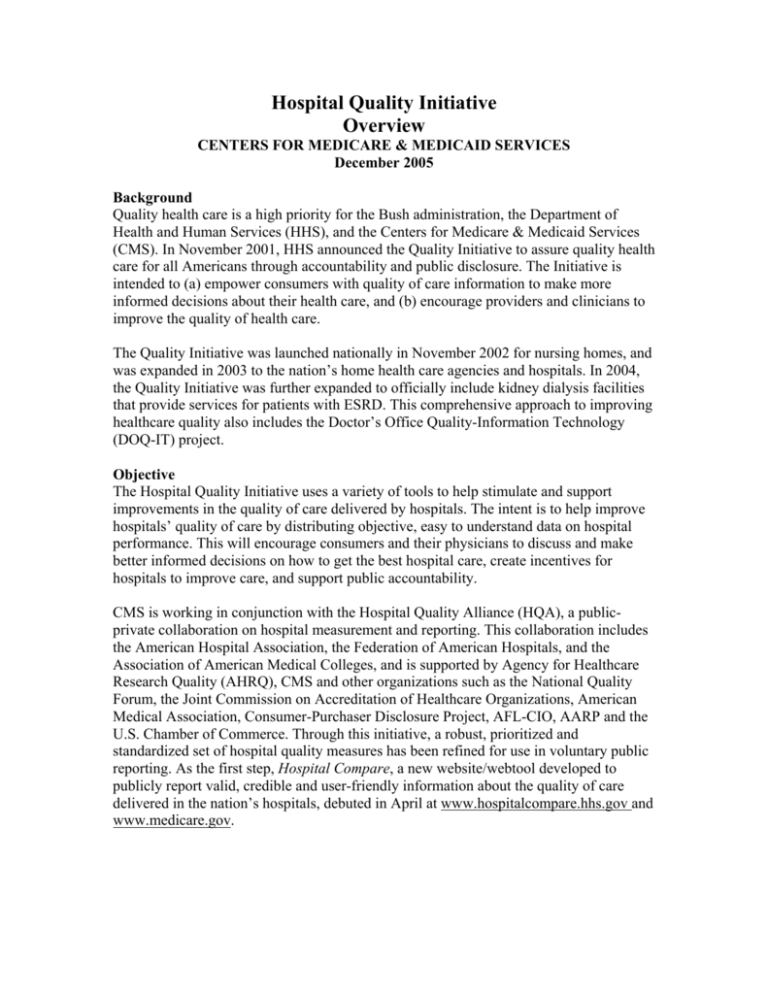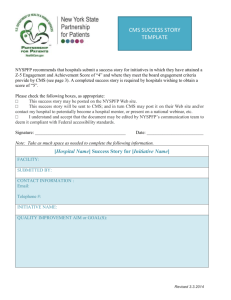Hospital Quality Initiative - Alliance for Health Reform
advertisement

Hospital Quality Initiative Overview CENTERS FOR MEDICARE & MEDICAID SERVICES December 2005 Background Quality health care is a high priority for the Bush administration, the Department of Health and Human Services (HHS), and the Centers for Medicare & Medicaid Services (CMS). In November 2001, HHS announced the Quality Initiative to assure quality health care for all Americans through accountability and public disclosure. The Initiative is intended to (a) empower consumers with quality of care information to make more informed decisions about their health care, and (b) encourage providers and clinicians to improve the quality of health care. The Quality Initiative was launched nationally in November 2002 for nursing homes, and was expanded in 2003 to the nation’s home health care agencies and hospitals. In 2004, the Quality Initiative was further expanded to officially include kidney dialysis facilities that provide services for patients with ESRD. This comprehensive approach to improving healthcare quality also includes the Doctor’s Office Quality-Information Technology (DOQ-IT) project. Objective The Hospital Quality Initiative uses a variety of tools to help stimulate and support improvements in the quality of care delivered by hospitals. The intent is to help improve hospitals’ quality of care by distributing objective, easy to understand data on hospital performance. This will encourage consumers and their physicians to discuss and make better informed decisions on how to get the best hospital care, create incentives for hospitals to improve care, and support public accountability. CMS is working in conjunction with the Hospital Quality Alliance (HQA), a publicprivate collaboration on hospital measurement and reporting. This collaboration includes the American Hospital Association, the Federation of American Hospitals, and the Association of American Medical Colleges, and is supported by Agency for Healthcare Research Quality (AHRQ), CMS and other organizations such as the National Quality Forum, the Joint Commission on Accreditation of Healthcare Organizations, American Medical Association, Consumer-Purchaser Disclosure Project, AFL-CIO, AARP and the U.S. Chamber of Commerce. Through this initiative, a robust, prioritized and standardized set of hospital quality measures has been refined for use in voluntary public reporting. As the first step, Hospital Compare, a new website/webtool developed to publicly report valid, credible and user-friendly information about the quality of care delivered in the nation’s hospitals, debuted in April at www.hospitalcompare.hhs.gov and www.medicare.gov. Critical Components: Broadly Accepted Hospital Quality Measures and Voluntary Reporting The Hospital Quality Initiative is complex and differs in several ways from the Nursing Home Quality Initiative and Home Health Quality Initiative. In the previous initiatives, CMS had well-studied and validated clinical data sets and standardized data transmission infrastructure from which to draw a number of pertinent quality measures for public reporting. In contrast with the earlier initiatives, there was no comprehensive data set on hospitals from which to develop the pertinent quality measures, nor are hospitals mandated to submit clinical performance data to CMS. However, section 501(b) of the Medicare Prescription Drug, Improvement, and Modernization Act of 2003 provided a strong incentive for eligible hospitals to submit quality data for ten quality measures known as the “starter set”. The law stipulates that a hospital that does not submit performance data for the ten quality measures will receive a 0.4 percentage points reduction in its annual payment update from CMS for FY 2005, 2006 and 2007. The twenty measures currently reported on Hospital Compare include the ten starter measures plus additional measures that many hospitals also voluntarily report. The measures represent wide agreement from CMS, the hospital industry and public sector stakeholders such as the Joint Commission on Accreditation of Healthcare Organizations (JCAHO), the National Quality Forum (NQF), and the Agency for Healthcare Research and Quality (AHRQ). The twenty hospital quality measures currently listed on Hospital Compare have gone through years of extensive testing for validity and reliability by CMS and the QIOs, the Joint Commission on Accreditation of Healthcare Organizations, the HQA and researchers. The hospital quality measures are also endorsed by the National Quality Forum, a national standards setting entity. Hospital Quality Measures Measure Aspirin at arrival Aspirin at discharge Beta-Blocker at arrival Beta-Blocker at discharge ACE Inhibitor or Angiotensin Receptor Blocker (ARB) for left ventricular systolic dysfunction Smoking cessation Thrombolytic agent received within 30 minutes of hospital arrival Percutaneous Coronary Intervention (PCI) received within 120 minutes of hospital arrival Left ventricular function assessment Condition Acute Myocardial Infarction (AMI)/Heart attack Heart Failure ACE Inhibitor or Angiotensin Receptor Blocker (ARB) for left ventricular systolic dysfunction Comprehensive discharge instructions Smoking cessation Initial antibiotic received within 4 hours of hospital arrival Pneumococcal vaccination status Blood culture performed before first antibiotic received Smoking cessation Oxygenation assessment Appropriate initial antibiotic selection Prophylactic antibiotic received within 1 hour prior to surgical incision Prophylactic antibiotics discontinued within 24 hours after surgery end time Pneumonia Surgical Infection Prevention These measures were chosen because they are related to three serious medical conditions and prevention of surgical infections and it is possible for hospitals to submit information on for public reporting today. Both JCAHO and CMS provide their own processes to submit data and use data edit procedures to check data for completeness and accuracy. In addition, the quality measures are well understood by providers and stakeholders and can be validated by CMS with existing resources through its QIO program. The ultimate goal of CMS and its collaborators in the HQA is for this set of measures to be reported by all hospitals, and accepted by all purchasers, oversight and accrediting entities, payers and providers In the future, additional quality measures will be added to Hospital Compare. CMS, along with its sister agency AHRQ, is in the final stages developing a standardized survey of patient perspectives of their hospital care, known as Hospital CAHPS (HCAHPS). Information from this survey will be publicly reported on Hospital Compare in the future. The survey has been tested by hospitals in Arizona, Maryland and New York as part of a CMS pilot project. Additional testing occurred in Connecticut and select sites around the country. Public reporting of standardized measures on patients’ perspectives of the quality of hospital care will encourage consumers and their physicians to discuss and make more informed decisions on how to get the best hospital care, as well as increase the public accountability of hospitals. The Quality Strategy The Quality Initiative employs a multi-pronged approach to support, provide incentives and drive systems and facilities – including the clinicians and professionals working in those settings – toward superior care through: • Ongoing regulation and enforcement conducted by State survey agencies and CMS • New consumer hospital quality information on our websites, www.hospitalcompare.hhs.gov and www.medicare.gov, and at 1-800-MEDICARE • The testing of rewards for superior performance on certain measures of quality • Continual, community-based quality improvement resources through the QIOs • Collaboration and partnership to leverage knowledge and resources Regulation and Enforcement CMS will continue to conduct regulation and enforcement activities to ensure that Medicare hospitals comply with federal standards for patient health and safety and quality of care. The survey and certification program is a joint effort of the federal and state governments to ensure safety and improve the quality of care in health care facilities. These activities provide an important view of the quality of care in hospitals. Consumer Information on Quality of Care CMS and the HQA will conduct an integrated communications campaign to encourage consumers and their physicians to discuss and make informed decisions on how to get the best hospital care. They will encourage patients to access hospital quality information on www.hospitalcompare.hhs.gov and www.medicare.gov or by calling 1-800MEDICARE. CMS will also direct the QIOs to promote awareness, understanding and use of quality measures by working with clinicians and intermediaries including primary care physicians, community organizations, and the media. Rewarding Superior Performance As part of the Hospital Quality Initiative, CMS is exploring pay-for-performance via the Premier Hospital Quality Incentive Demonstration. Under the demonstration, hospitals will receive bonuses based on their performance on quality measures selected for inpatients with specific clinical conditions: heart attack, heart failure, pneumonia, coronary artery bypass graft, and hip and knee replacements. Hospitals will be scored on the quality measures related to each condition measured. Composite scores will be calculated annually for each demonstration hospital. Separate scores will be calculated for each clinical condition by “rolling up” individual measures into an overall score. CMS will categorize the distribution of hospital scores into deciles to identify top performers for each condition. For each condition, all of the hospitals in the top 50% will be reported as top performers. Those hospitals in the top 20% will be recognized and given a financial bonus. By the end of the demonstration, it is anticipated that participating hospitals will show improvement from performance in year one. In year three, hospitals will receive lower payments if they score below clinical baselines set in the first year for the bottom 20% of hospitals. Community-based Quality Improvement The QIOs will continue to work with hospitals to improve performance on the hospitalreported measures and to develop and implement continuous quality improvement programs. The QIOs have worked with physicians, hospitals, and other providers on improvement activities for the past 20 years and have seen providers achieve a 10-20% relative improvement in performance. For the past three years, the QIOs have been working with hospitals to improve performance on most of the starter set of 10 hospital quality measures. During this period, performance on these measures has improved across the country. As part of this initiative, the QIOs are also working with community, health care and business organizations, and with the local media to provide quality information to the public and encourage hospitals to use the information to improve care. Collaboration and Partnership To be effective, the Hospital Quality Initiative must truly be a collaborative effort with hospitals and their associations, physicians, other clinicians, federal and state agencies, QIOs, independent health care quality organizations, private purchasers, accrediting organizations, and consumer advocates. The initiative is designed to improve communication among all parties to positively impact quality of care. By collaborating to expand knowledge and resources, all partners can achieve greater and immediate improvements in the quality of hospital care. The HQA, mentioned earlier, is a prime example of a cooperative effort in the Hospital Quality Initiative.






